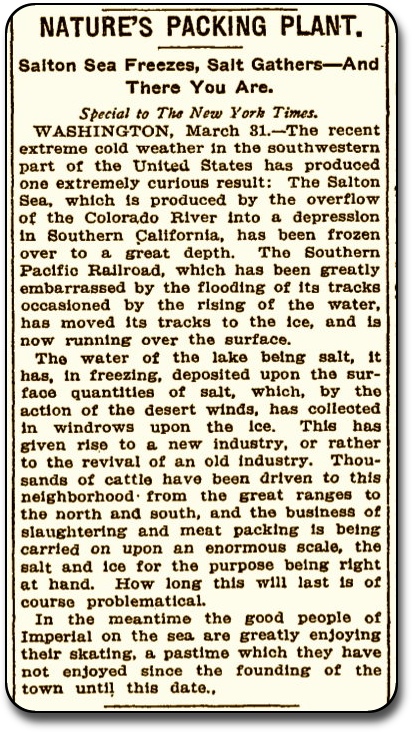The New York Times does not participate in the custom of April Fool's Day. It's the paper that only publishes "news that's fit to print," and April fool absurdities don't make the cut.
Except for one time that maybe it did publish an April fool story. It was way back on April 1, 1906 when
the following story appeared on the front page of the Times.
It's an odd story. It's not really laugh-out-loud funny. But anyone familiar with the climate around the Salton Sea would immediately realize that the idea that it had frozen solid was absurd. And ice skating on the Salton Sea? Never happened.
Six days later, on April 7, the
Los Angeles Times called out the story, in a column headlined "A Masterpiece of Fooling".
A MASTERPIECE OF FOOLING
Under the caption "Nature's Packing Plant" and a special Washington date line, the conservative New York Times of April 1 prints on its first page this remarkable piece of news in all apparent seriousness...
[text of the NYT article]
It seems a pity to spoil an April Fool Day gem like that, but lest some of our visitors get out their skates and stampede to the Imperial country to have a frolic on the ice, it may be as well to mention the fact that the Salton sink is considerably below sea level and, next to Death Valley, the nearest to the infernal regions, in winter or summer, of any spot on the crust of the earth, with a climate appropriate to its location.
The day on which the story appeared in the New York paper, the first of April, is not without significance. It is a peach of a story, but it is no more fantastic than some of the yarns about the Salton Sea and the Imperial country, faked up as real news and published with fake illustrations by Hearst's Los Angeles paper.
Wonder who gave the New York Times that "fill!" Or did that journal deliberately pass it out to the readers of its telegraphic dispatches?
It's possible, as the
LA Times speculated, that the NYT was fooled by someone else and didn't intend to publish a fake story. However, the NYT article said that the news was "special to The New York Times," which suggests to me that it was their own story.
The story later got picked up by a few other publications, such as the
Daily Public Ledger (Maysville, Ky - Apr 19, 1906), which accepted the news uncritically.
However,
The National Provisioner - Apr 28, 1906, noted that the story "may be taken with a liberal allowance of the salt he speaks of."


Comments